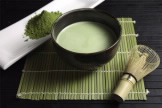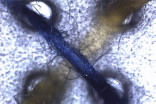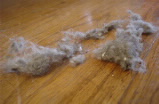FOR IMMEDIATE RELEASE
ACS News Service Weekly PressPac: February 17, 2010
ACS News Service Weekly PressPac: February 17, 2010
Contact
- Science Inquiries: Michael Woods, Editor, 202-872-6293
- General Inquiries: Michael Bernstein, 202-872-6042
![]()
Scientists have confirmed that the healthful substances found in green tea — renowned for their powerful antioxidant and disease-fighting properties — do penetrate into tissues of the eye. Their new report, the first documenting how the lens, retina, and other eye tissues absorb these substances, raises the possibility that green tea may protect against glaucoma and other common...
![]()

Scientists in Australia are reporting the first use of ordinary cotton thread and sewing needles to literally stitch together a microfluidic analytical device — microscopic technology that can transport fluids for medical tests and other purposes in a lab-on-a-chip. The chips shrink room-sized diagnostic testing equipment down to the size of a postage stamp, and promise revolutionary...
![]()

Where does it come from? Scientists in Arizona are reporting a surprising answer to that question, which has puzzled and perplexed generations of men and women confronted with layers of dust on furniture and floors. Most of indoor dust comes from outdoors. Their report appears in the ACS’ Environmental Science & Technology, a semi-monthly journal. In the study, David Layton and Paloma...
![]()

Call them oil droplets with a brain or even “chemo-rats.” Scientists in Illinois have developed a way to make simple oil droplets “smart” enough to navigate through a complex maze almost like a trained lab rat. The finding could have a wide range of practical implications, including helping cancer drugs to reach their target and controlling the movement of futuristic nano-machines...
![]()
In an effort to sidestep the ethical dilemma involved in using human embryonic stem cells to treat diseases, scientists are developing non-controversial alternatives: In particular, they are looking for drug-like chemical compounds that can transform adult skin cells into the stem cells now obtained from human embryos. That’s the topic of a fascinating article in Chemical & Engineering News (C&EN), ACS’ weekly newsmagazine. C&EN Associate Editor Sarah Everts notes that in 2006, researchers in Japan figured out…
![]()
Journalists’ Resources

- Media Registration ACS 239th National Meeting, March 21-25, 2010, San Francisco
News media accreditation and housing reservations are now open for the 239th National Meeting & Exhibition of the American Chemical Society (ACS), the world’s largest scientific society. It will be held March 21-25 in San Francisco. Reporters and editors can apply for complimentary registration now at meeting registration. Hotel reservations and other information are available at housing. - Press releases, briefings, and more from ACS’ 238th National Meeting
www.eurekalert.org/acsmeet.php
http://www.ustream.tv/channel/acslive - Must-reads from C&EN: The mystery of why there are so few new antibiotics
Antibiotics are among the most straight-forward drugs to develop. Nevertheless, only two new classes of these lifesavers –– oxazolidineones and lipopeptides –– have reached the market since the 1970s. Only four drug companies are active in developing antibiotics today, compared to virtually all 20 years ago. To find out why, get a copy of the story from m_bernstein@acs.org. - ACS Pressroom Blog The ACS Office of Public Affairs’ (OPA) pressroom blog highlights research from ACS’ 38 peer-reviewed journals and National Meetings.
- Bytesize Science blog Educators and kids, put on your thinking caps: The American Chemical Society has a blog for Bytesize Science, a science podcast for kids of all ages.
- ACS satellite pressroom: Daily news blasts on Twitter
The satellite press room has become one of the most popular science news sites on Twitter. To get our news blasts and updates, create a free account at https://twitter.com/signup. Then visit http://twitter.com/ACSpressroom and click the ‘join’ button beneath the press room logo. - C&EN on Twitter
Follow @cenmag <http://twitter.com/cenmag> for the latest news in chemistry and dispatches from our blog, C&ENtral Science <http://centralscience.org>. - ACS Press Releases
Press releases on a variety of chemistry-related topics. - General Chemistry Glossary
- Chemical Abstracts Service (CAS) Web site on everyday chemicals
Whether you want to learn more about caffeine, benzoyl peroxide (acne treatment), sodium chloride (table salt), or some other familiar chemical, CAS Common Chemistry can help. The new Web site provides non-chemists and others with useful information about everyday chemicals by searching either a chemical name or a corresponding CAS Registry Number. The site includes about 7,800 chemicals of general interest as well as all 118 elements from the Periodic Table, providing alternative names, molecular structures, a Wikipedia link, and other information. - Science Connections from CAS
CAS - Science Connections is a series of articles that showcases the value of CAS databases in light of important general-interest science and technology news. Topics range from fruit flies to Nobel Prize winners, with the CAS - Science Connections series pointing to CAS databases for a more complete understanding of the latest news.
- Bytesize Science
Bytesize Science is a science podcast for kids of all ages that entertains and educates, with new high-definition video podcasts and some episodes in Spanish. Subscribe to Bytesize Science using iTunes. No iTunes? No problem. Listen to the latest episodes of Bytesize Science in your web browser. - Global Challenges/Chemistry Solutions
This special series of ACS podcasts focuses on some of the 21st Century’s most daunting challenges, and how chemists and other scientists are finding solutions. Subscribe at iTunes or listen and access other resources at the ACS web site www.acs.org/GlobalChallenges. - Science Elements
Science Elements is a podcast of PressPac contents that makes cutting-edge scientific discoveries from ACS journals available to a broader public audience. Subscribe to Science Elements using iTunes. Listen to the latest episodes of Science Elements in your web browser. - SciFinder® Podcasts
Interested in healthful plant phytochemicals, nanotechnology, or green chemistry? Check out the SciFinder series of podcasts, which explore a vast array of current interest topics and new discoveries in the 21st century. The SciFinder podcasts are available in English, Chinese, Japanese, and Portuguese.
Note to Journalists and Other Viewers
This is the latest American Chemical Society (ACS) Office of Public Affairs Weekly PressPac with news from ACS’ 38 peer-reviewed journals and Chemical & Engineering News.
This information is intended for your personal use in news gathering and reporting and should not be distributed to others. Anyone using advance ACS Office of Public Affairs Weekly PressPac information for stocks or securities dealing may be guilty of insider trading under the federal Securities Exchange Act of 1934.
Please cite the individual journal, or the American Chemical Society, as the source of this information.
The American Chemical Society is a nonprofit organization chartered by the U.S. Congress. With more than 161,000 members, ACS is the world’s largest scientific society and a global leader in providing access to chemistry-related research through its multiple databases, peer-reviewed journals and scientific conferences. Its main offices are in Washington, D.C., and Columbus, Ohio.

